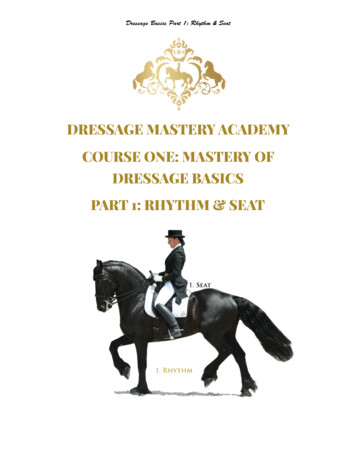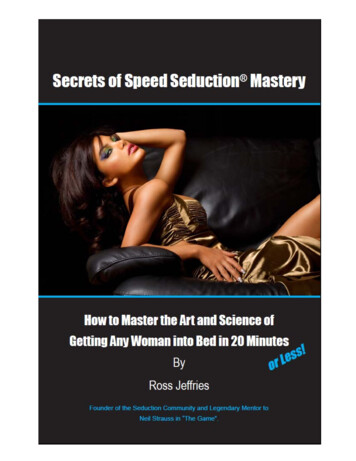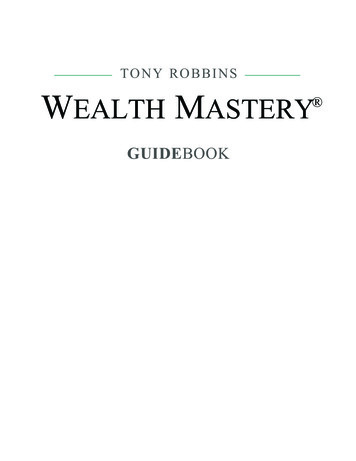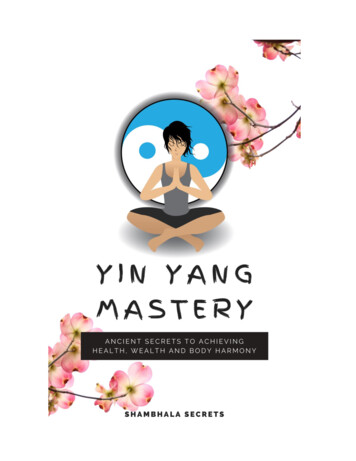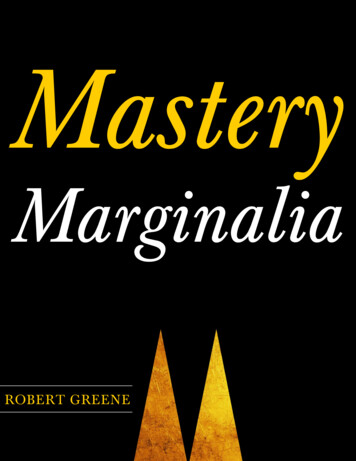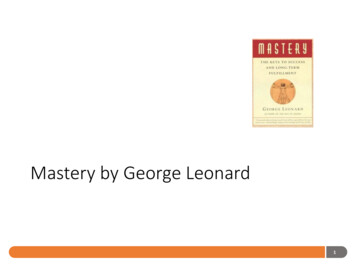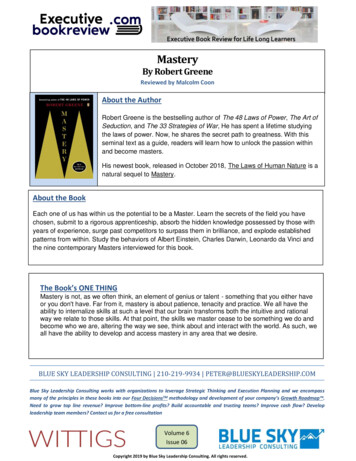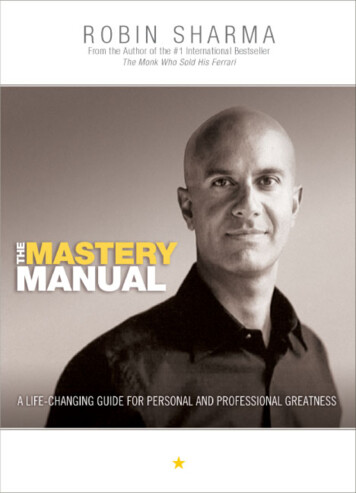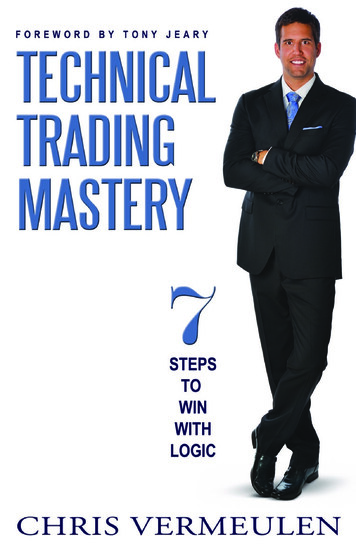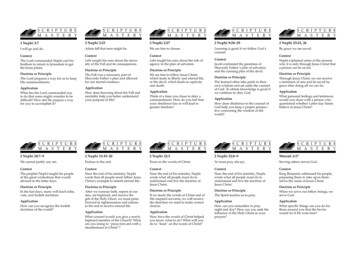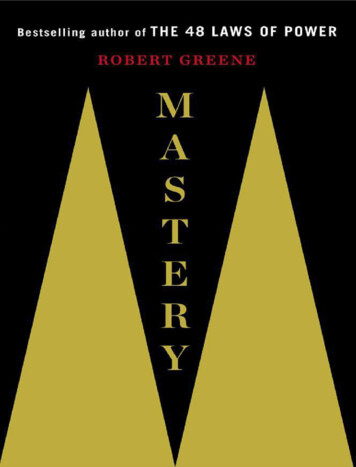
Transcription
MASTERY
ALSO BY ROBERTGREENEThe 50th Law (with 50 Cent)The 33 Strategies of War(A Joost Elfers Production)The Art of Seduction(A Joost Elfers Production)The 48 Laws of Power(A Joost Elfers Production)
ROBERT GREENE
MASTERYVIKING
VIKINGPublished by the Penguin GroupPenguin Group (USA) Inc., 375 HudsonStreet, New York, New York 10014,U.S.A. Penguin Group (Canada), 90Eglinton Avenue East, Suite 700,Toronto, Ontario, Canada M4P 2Y3 (adivision of Pearson Penguin CanadaInc.) Penguin Books Ltd, 80 Strand,London WC2R 0RL, England PenguinIreland, 25 St. Stephen’s Green, Dublin2, Ireland (a division of Penguin BooksLtd) Penguin Books Australia Ltd, 250Camberwell Road, Camberwell,Victoria 3124, Australia (a division ofPearson Australia Group Pty Ltd) Penguin Books India Pvt Ltd, 11Community Centre, Panchsheel Park,
New Delhi—110 017, India PenguinGroup (NZ), 67 Apollo Drive,Rosedale, Auckland 0632, New Zealand(a division of Pearson New ZealandLtd) Penguin Books (South Africa)(Pty) Ltd, 24 Sturdee Avenue, Rosebank,Johannesburg 2196, South AfricaPenguin Books Ltd, Registered Offices:80 Strand, London WC2R 0RL, EnglandFirst published in 2012 by VikingPenguin,a member of Penguin Group (USA) Inc.Copyright Robert Greene, 2012All rights reserved
Library of Congress Cataloging-inPublication DataGreene, Robert.Mastery / Robert Greene.p. cm.Includes bibliographical references (p.)and index.ISBN: 978-1-101-60102-01. Successful people. 2. Success.3. Self-actualization (Psychology) I.Title.BF637.S8G695 2012158—dc232012027195No part of this book may be reproduced,scanned, or distributed in any printed orelectronic form without permission.
Please do not participate in or encouragepiracy of copyrighted materials inviolation of the author’s rights. Purchaseonly authorized editions.
To Anna
CONTENTSINTRODUCTIONTHE ULTIMATE POWERHigher intelligence—definition of mastery—thethree phases of mastery—intuitive intelligence—connecting to reality—the latent power within usallTHE EVOLUTION OF MASTERYOur primitive ancestors—evolution of the humanbrain—the ability to detach and focus—socialintelligence of early hominids—mirror neurons—thinking inside—mastery of time—working withthe grain of the human brain—connecting to ourearly rootsKEYS TO MASTERYCharles Darwin following his inclination—traitsof all great Masters—our uniqueness and primalinclinations—political barriers to mastery
crumbling—definition of genius—the concept ofmastery denigrated—role of desire in mastery—the danger of passivity—the plasticity of thebrain—overview of strategies and biographicalfigures in the bookI.DISCOVER YOUR CALLING:THE LIFE’S TASKYou possess an inner force that seeks to guideyou toward your Life’s Task—what you aremeant to accomplish in the time that you have tolive. The first move toward mastery is alwaysinward—learning who you really are andreconnecting with that innate force. Knowing itwith clarity, you will find your way to the propercareer path and everything else will fall intoplace. It is never too late to start this process.THE HIDDEN FORCELeonardo da Vinci
KEYS TO MASTERYExamples of Masters guided by a sense ofdestiny—the seed of your uniqueness—reconnecting with your inclinations—definitionof “vocation”—choosing a vocation—findingyour niche—the quest for accomplishment—learnwho you really areSTRATEGIES FOR FINDING YOUR LIFE’STASK1. Return to your origins—The primalinclination strategyAlbert Einstein—Marie Curie—IngmarBergman—Martha Graham—Daniel Everett—John Coltrane2. Occupy the perfect niche—The DarwinianstrategyA. V. S. RamachandranB. Yoky Matsuoka3. Avoid the false path—The rebellionstrategyWolfgang Amadeus Mozart
4. Let go of the past—The adaptationstrategyFreddie Roach5. Find your way back—The life-or-deathstrategyBuckminster FullerREVERSALTemple GrandinII.SUBMIT TO REALITY:THE IDEAL APPRENTICESHIPAfter your formal education, you enter the mostcritical phase in your life—a second, practicaleducation known as The Apprenticeship. Beforeit is too late you must learn the lessons andfollow the path established by the greatestMasters, past and present—a kind of IdealApprenticeship that transcends all fields. In theprocess you will master the necessary skills,
discipline your mind, and transform yourself intoan independent thinker, prepared for thecreative challenges on the way to mastery.THE FIRST TRANSFORMATIONCharles DarwinKEYS TO MASTERYThe Ideal Apprenticeship defined—the goal ofapprenticeship as self-transformationThe Apprenticeship Phase—The Three Steps or ModesStep One: Deep Observation—The PassiveModeMute your colors—observe the rules—observepower relationships—interpretation of CharlesDarwin story—know your environmentStep Two: Skills Acquisition—The PracticeModeGaining tacit knowledge—the apprenticeshipsystem of the Middle Ages—the cycle ofaccelerated returns—embracing tedium—thefrontal cortex and learning tasks—hard-wiring
knowledge—the magical number of 10,000hoursStep Three: Experimentation—The ActiveModeGradual self-assertion and experiment—overcoming fearsSkill acquisition in the modern world—relevanceof apprenticeship—the hand-eye connection—you are a builderSTRATEGIES FOR COMPLETING THEIDEALAPPRENTICESHIP1. Value learning over moneyBenjamin Franklin—Albert Einstein—Martha Graham—Freddie Roach2. Keep expanding your horizonsZora Neale Hurston3. Revert to a feeling of inferiorityDaniel Everett4. Trust the process
Cesar Rodriguez5. Move toward resistance and painA. Bill BradleyB. John Keats6. Apprentice yourself in failureHenry Ford7. Combine the “how” and the “what”Santiago Calatrava8. Advance through trial and errorPaul GrahamReversalWolfgang Amadeus Mozart—Albert EinsteinIII.ABSORB THE MASTER’S POWER:THE MENTOR DYNAMICLife is short, and your time for learning andcreativity is limited. Without any guidance, youcan waste valuable years trying to gain
knowledge and practice from various sources.Instead, you must follow the example set byMasters throughout the ages and find the propermentor. Choose the mentor who best fits yourneeds and connects to your Life’s Task. Onceyou have internalized their knowledge, you mustmove on and never remain in their shadow. Yourgoal is always to surpass your mentors inmastery and brilliance.THE ALCHEMY OF KNOWLEDGEMichael FaradayKEYS TO MASTERYThe importance of humility—the value of mentors—the mentor-protégé dynamic—learning asalchemy—interpretation of Michael Faradaystory—Alexander the Great—the value ofpersonal interaction—finding and attracting amentor—famous figures or books as mentors—the mentor as father figure—when to cut theMasterSTRATEGIES FOR DEEPENING
THE MENTOR RELATIONSHIP1. Choose the mentor according to yourneeds and inclinationsFrank Lloyd Wright—Carl Jung—V. S.Ramachandran—Yoky Matsuoka2. Gaze deep into the mentor’s mirrorHakuin Zenji3. Transfigure their ideasGlenn Gould4. Create a back-and-forth dynamicFreddie RoachREVERSALThomas EdisonIV.SEE PEOPLE AS THEY ARE:SOCIAL INTELLIGENCEOften the greatest obstacle to our pursuit ofmastery comes from the emotional drain we
experience in dealing with the resistance andmanipulations of the people around us. Wemisread their intentions and react in ways thatcause confusion or conflict. Social intelligence isthe ability to see people in the most realistic lightpossible. Navigating smoothly through the socialenvironment, we have more time and energy tofocus on learning and acquiring skills. Successattained without this intelligence is not truemastery, and will not last.THINKING INSIDEBenjamin FranklinKEYS TO MASTERYHumans as the preeminent social animal—theNaïve Perspective holding us back—interpretation of Benjamin Franklin story—adjusting your attitudeSpecific Knowledge—Reading PeopleNonverbal communication—paying attention tocues—looking for common emotionalexperiences—reading people intuitively—looking for patterns—the danger of first
impressionsGeneral Knowledge—The Seven enessLazinessFlightinessPassive AggressionSocial intelligence and creativitySTRATEGIES FOR ACQUIRINGSOCIAL INTELLIGENCE1. Speak through your workA. Ignaz SemmelweisB. William Harvey2. Craft the appropriate personaTeresita Fernández3. See yourself as others see youTemple Grandin
4. Suffer fools gladlyJohann Wolfgang von Goethe—Josef vonSternberg—Daniel EverettREVERSALPaul GrahamV.AWAKEN THE DIMENSIONALMIND:THE CREATIVE-ACTIVEAs you accumulate more skills and internalizethe rules that govern your field, your mind willwant to become more active, seeking to use thisknowledge in ways that are more suited to yourinclinations. Instead of feeling complacent aboutwhat you know, you must expand yourknowledge to related fields, giving your mindfuel to make new associations between differentideas. In the end, you will turn against the veryrules you have internalized, shaping and
reforming them to suit your spirit. Suchoriginality will bring you to the heights of power.THE SECOND TRANSFORMATIONWolfgang Amadeus MozartKEYS TO MASTERYThe Original Mind—the Conventional Mind—theDimensional Mind—interpretation of Mozartstory—the three essential stepsStep One: The Creative TaskAltering your concept of creativity—searchingfor the Great White Whale—Thomas Edison,Rembrandt, Marcel Proust, and the ultimatecreative challenges—The Primary Law of theCreative Dynamic—finding something to rebelagainst—remaining realistic—letting go ofsecurityStep Two: Creative StrategiesA. CULTIVATE NEGATIVECAPABILITY
Keats on the creative process—definitionof Negative Capability—Mozart and Bach—Einstein and Negative Capability—Shakespeare as ideal—Faraday onhumility—Negative Capability as a tool toopen the mindB. ALLOW FOR SERENDIPITYThe brain as a dual processing system—definition of “serendipity”—WilliamJames and mental momentum—maintaining openness of spirit—LouisPasteur and serendipity—Thomas Edison,serendipity, and the recording of sound—the fluid mind—serendipity strategies ofAnthony Burgess and Max Ernst—cultivating serendipity—analogicalthinking and GalileoC. ALTERNATE THE MIND THROUGH“THE CURRENT”Charles Darwin and the Current—definition of “the Current”—our primitiveancestors and the Current—short-
circuiting the Current—BuckminsterFuller and artifacts—the importance ofcreating objects—feedback loopD. ALTER YOUR PERSPECTIVETypical patterns of thinking to alterLooking at the “what” instead of the “how”Avoiding shorthand—focusing on thestructure—getting a feel for the whole—theimportance of relationships in scienceRushing to generalities and ignoring detailsShifting from the macro to the micro—Charles Darwin and the micro-study ofbarnacles—Leonardo da Vinci’s attentionto micro-detail in painting—letting detailsguide youConfirming paradigms and ignoring anomaliesOverdependence on paradigms—the valueof anomalies—Marie Curie and theanomaly of radioactivity—the founders ofGoogle and anomalies—anomalies fuelingevolution
Fixating on what is present, ignoring what isabsentSherlock Holmes and negative cues—Gowland Hopkins, negative cues, andscurvy—meeting unfulfilled needs—HenryFord, negative cues, and the assembly line—reversing your emotional perspective—setbacks as opportunitiesE. REVERT TO PRIMAL FORMS OFINTELLIGENCEThe intelligence of our primitive ancestors—the human brain as a multiuse instrument—grammar as a limitation—thinkingbeyond language—examples of famouspeople who thought in images—thelimitations of memory—using diagrams andmodels—Schiller, Einstein, SamuelJohnson, and synesthesiaStep Three: The Creative Breakthrough—Tension and InsightThe high internal standards of Masters—lettinggo—Einstein, letting go, and the discovery of
relativity—Richard Wagner completing his operain a dream—how the brain reaches peaks ofcreativity—blocks that precede enlightenment—Evariste Galois’s sudden burst of genius—theneed for tension—manufacturing deadlines—Thomas Edison’s manufacture of pressureEmotional eGrandiosityInflexibilitySTRATEGIES FOR THE CREATIVEACTIVE PHASE1. The Authentic VoiceJohn Coltrane2. The Fact of Great YieldV. S. Ramachandran3. Mechanical Intelligence
The Wright brothers4. Natural PowersSantiago Calatrava5. The Open FieldMartha Graham6. The High EndYoky Matsuoka7. The Evolutionary HijackPaul Graham8. Dimensional ThinkingJean-François Champollion9. Alchemical Creativity and theUnconsciousTeresita FernándezREVERSALJohn Coltrane—August StrindbergVI.
FUSE THE INTUITIVE WITHTHE RATIONAL: MASTERYAll of us have access to a higher form ofintelligence, one that can allow us to see more ofthe world, to anticipate trends, to respond withspeed and accuracy to any circumstance. Thisintelligence is cultivated by deeply immersingourselves in a field of study and staying true toour inclinations, no matter how unconventionalour approach might seem to others. This poweris what our brains were designed to attain, andwe will be naturally led to this type ofintelligence if we follow our inclinations to theirultimate ends.THE THIRD TRANSFORMATIONMarcel ProustKEYS TO MASTERYExamples of Masters seeing more—the fingertipfeel—a power that is mystified— high-levelintuition—the Dynamic—gaining an intuitive feelfor the whole—Jane Goodall’s feel for
chimpanzees—Erwin Rommel’s feel for battle—the fusing of the rational and the intuitive—mastery at 20,000 hours—time as a crucialfactor—make study time qualitatively rich—interpretation of Proust storyThe Roots of Masterly IntuitionThe Ammophila wasp—intuition and ourprimitive ancestors—mnemonic networks in thebrain—Bobby Fischer and memory traces—engaging with complexity—gaining a tolerancefor chaos—increasing memory capacity—examples of high-level intuition andyouthfulnessThe Return to RealityOverview of evolution from the beginning—theinterconnectedness of all life—the ultimatereality—our modern Renaissance—returning tothe whole—the altered brain of the
Greene, Robert. Mastery / Robert Greene. p. cm. Includes bibliographical references (p.) and index. ISBN: 978-1-101-60102-0 1. Successful people. 2. Success. 3. Self-actualization (Psychology) I. Title. BF637.S8G695 2012 158—dc23 2012027195 No part of this book may be reproduced, scanned, or distributed in any printed or electronic form without permission. Please do not participate in or .
